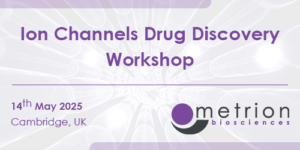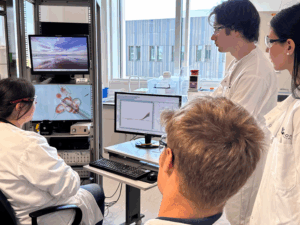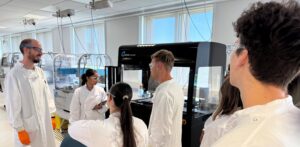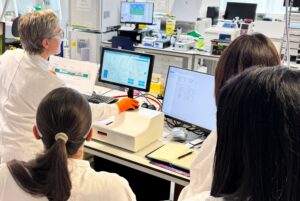 Following the success of our first Ion Channels Drug Discovery Workshop in 2023, we repeated the event to give PhD students and early career postdocs an opportunity to see how ion channels are used in drug discovery research applications, specifically in a CRO setting.
Following the success of our first Ion Channels Drug Discovery Workshop in 2023, we repeated the event to give PhD students and early career postdocs an opportunity to see how ion channels are used in drug discovery research applications, specifically in a CRO setting.
“The workshop is limited in number so students get the most from discussion and demonstrations. They learned about electrophysiology concepts, sodium channels in drug discovery and the commercial business-side of ion channels. Following the overwhelmingly positive experience from the students I’m looking forward to hosting this event again to inspire the next generation of ion channel scientists,” commented Dr Eddy Stevens, CSO at Metrion. “Thank you to Sophion for supporting the event, specifically Dr Damian Bell, Global Scientific Affairs Director, who presented the overview of ion channel screening.”
A number of talks and demonstrations were delivered. Here we highlight, Dr Damian Bell (Sophion Bioscience) who gave an overview and discussion on ion channel drug discovery. This covered his career path through a multitude of environments from training in academia, to the tiny and large pharmas, biotechs and CROs, ultimately leading to automated patch clamp (APC) design, making and applications in drug discovery. Using a typical drug screening cascade to guide the talk and student discussions, he highlighted the key stages in going from choosing the ‘right’ ion channel (target selection and validation), through drug discovery (primary and secondary screens) and development (lead optimisation, toxicology and safety pharmacology), into efficacy and translation in the clinic. At each stage techniques and processes employed were discussed, and how APC is a key driver in advancing ion channel research to develop better drugs to treat patients.
Students were split into small groups to observe demonstrations of the techniques and assays that are run daily at Metrion.
Dr Remis Lape (Senior Scientist II), demonstrated manual patch clamp of hNav1.5 currents from our in-house stable cell line. The students had the opportunity to learn about the process of manual patch clamp, observe how currents are recorded and then analyse basic biophysical properties. They also had the opportunity to learn more about Nav1.5 and its importance as part of our Comprehensive In vitro Proarrhythmia Assay (CiPA) panel used to assess the proarrhythmic liability of potential new drug candidates.
In the second demonstration, Dr Katie Puddefoot (Senior Scientist I) demonstrated the lysosomal patch-clamp, a specialist manual patch service offered by Metrion. Students observed the technical process of removing the lysosome from the cell before recording TRPML-1 currents using a known activator. The students were engaged and asked lots of questions throughout their time with the Manual Patch Clamp Team.
It was an enjoyable and informative afternoon for both the visiting students, and the Metrion scientists.

Figure 1. Dr Katie Puddefoot, demonstrates how to isolate and manually patch-clamp a lysosome.
Two experiments were set up for the visiting students to observe and discuss the role of automated electrophysiology techniques in industry and academia.
Dr Sarah Lilley (Application Scientist, Sophion demonstrated the versatility of the QPatch Compact (Sophion) for investigating the biophysical properties and pharmacology of ion channels. Sarah guided students through the setup and running of experiments on hNaV1.7, an important target in Metrion’s neuroscience pain research offerings.
Dr Thomas Hill (Senior Scientist II) demonstrated the Qube384 (Sophion) platform in its fully automated unattended mode, which is used for our high-throughput screening. The students asked many questions, which lead to discussions about the use of all the different platforms available and how they are used at different stages of the drug discovery process.
The students went away with a better understanding of the role of automation in ion channel drug discovery and Metrion scientists have helped to inspire the next generation of drug discovery scientists.

Figure 2. Dr Thomas Hill demonstrates the use of automated electrophysiology platforms.

Figure 3. Dr Sarah Lilley highlights the ease and efficiency of automated patch clamp ion channel recordings on the desktop QPatch Compact.
Feedback from students included:
“My interest in ion channels has increased – I didn’t think that was possible.”
“I was already very interested in ion channels, and despite already studying NaV channels, Eddy's talk on them somehow made me even more so.”
“I found the talks particularly engaging and inspiring - especially the discussion about NaV1.7, NaV1.8 and NaV1.9 drug discovery campaigns.”
“The talks were probably the best part, though getting to see manual patch (both NaV1.5 CHO and Lysosome) were fantastic.”
“Learning about the day to day of working at a CRO and the opportunity to speak to different people about how they transitioned from academia to industry.”
“Having had no previous insight or real knowledge about CROs, it was very informative.”
“The insight into what it’s like working at a CRO has inspired me to pursue this career.”
Below are a selection of posters presented by students attending the workshop.
Mechanistic Studies of Small Molecule CFTR Modulators that Restore Channel Function to CFTR Variants, University of Bristol
Robust Platform for Recombinant Production of Animal Venom Toxin Modulators of Ion Channels, University of Cambridge
The MIDAS Motif and Glycosylation of CACHD1 are Important for Expression and Function as a CaV3.1 Voltage-gated Calcium Channel Modulator, University of Reading
 Following the success of our first Ion Channels Drug Discovery Workshop in 2023, we repeated the event to give PhD students and early career postdocs an opportunity to see how ion channels are used in drug discovery research applications, specifically in a CRO setting.
Following the success of our first Ion Channels Drug Discovery Workshop in 2023, we repeated the event to give PhD students and early career postdocs an opportunity to see how ion channels are used in drug discovery research applications, specifically in a CRO setting.
“The workshop is limited in number so students get the most from discussion and demonstrations. They learned about electrophysiology concepts, sodium channels in drug discovery and the commercial business-side of ion channels. Following the overwhelmingly positive experience from the students I’m looking forward to hosting this event again to inspire the next generation of ion channel scientists,” commented Dr Eddy Stevens, CSO at Metrion. “Thank you to Sophion for supporting the event, specifically Dr Damian Bell, Global Scientific Affairs Director, who presented the overview of ion channel screening.”
A number of talks and demonstrations were delivered. Here we highlight, Dr Damian Bell (Sophion Bioscience) who gave an overview and discussion on ion channel drug discovery. This covered his career path through a multitude of environments from training in academia, to the tiny and large pharmas, biotechs and CROs, ultimately leading to automated patch clamp (APC) design, making and applications in drug discovery. Using a typical drug screening cascade to guide the talk and student discussions, he highlighted the key stages in going from choosing the ‘right’ ion channel (target selection and validation), through drug discovery (primary and secondary screens) and development (lead optimisation, toxicology and safety pharmacology), into efficacy and translation in the clinic. At each stage techniques and processes employed were discussed, and how APC is a key driver in advancing ion channel research to develop better drugs to treat patients.
Students were split into small groups to observe demonstrations of the techniques and assays that are run daily at Metrion.
Dr Remis Lape (Senior Scientist II), demonstrated manual patch clamp of hNav1.5 currents from our in-house stable cell line. The students had the opportunity to learn about the process of manual patch clamp, observe how currents are recorded and then analyse basic biophysical properties. They also had the opportunity to learn more about Nav1.5 and its importance as part of our Comprehensive In vitro Proarrhythmia Assay (CiPA) panel used to assess the proarrhythmic liability of potential new drug candidates.
In the second demonstration, Dr Katie Puddefoot (Senior Scientist I) demonstrated the lysosomal patch-clamp, a specialist manual patch service offered by Metrion. Students observed the technical process of removing the lysosome from the cell before recording TRPML-1 currents using a known activator. The students were engaged and asked lots of questions throughout their time with the Manual Patch Clamp Team.
It was an enjoyable and informative afternoon for both the visiting students, and the Metrion scientists.

Figure 1. Dr Katie Puddefoot, demonstrates how to isolate and manually patch-clamp a lysosome.
Two experiments were set up for the visiting students to observe and discuss the role of automated electrophysiology techniques in industry and academia.
Dr Sarah Lilley (Application Scientist, Sophion demonstrated the versatility of the QPatch Compact (Sophion) for investigating the biophysical properties and pharmacology of ion channels. Sarah guided students through the setup and running of experiments on hNaV1.7, an important target in Metrion’s neuroscience pain research offerings.
Dr Thomas Hill (Senior Scientist II) demonstrated the Qube384 (Sophion) platform in its fully automated unattended mode, which is used for our high-throughput screening. The students asked many questions, which lead to discussions about the use of all the different platforms available and how they are used at different stages of the drug discovery process.
The students went away with a better understanding of the role of automation in ion channel drug discovery and Metrion scientists have helped to inspire the next generation of drug discovery scientists.

Figure 2. Dr Thomas Hill demonstrates the use of automated electrophysiology platforms.

Figure 3. Dr Sarah Lilley highlights the ease and efficiency of automated patch clamp ion channel recordings on the desktop QPatch Compact.
Feedback from students included:
“My interest in ion channels has increased – I didn’t think that was possible.”
“I was already very interested in ion channels, and despite already studying NaV channels, Eddy's talk on them somehow made me even more so.”
“I found the talks particularly engaging and inspiring - especially the discussion about NaV1.7, NaV1.8 and NaV1.9 drug discovery campaigns.”
“The talks were probably the best part, though getting to see manual patch (both NaV1.5 CHO and Lysosome) were fantastic.”
“Learning about the day to day of working at a CRO and the opportunity to speak to different people about how they transitioned from academia to industry.”
“Having had no previous insight or real knowledge about CROs, it was very informative.”
“The insight into what it’s like working at a CRO has inspired me to pursue this career.”
Below are a selection of posters presented by students attending the workshop.
Mechanistic Studies of Small Molecule CFTR Modulators that Restore Channel Function to CFTR Variants, University of Bristol
Robust Platform for Recombinant Production of Animal Venom Toxin Modulators of Ion Channels, University of Cambridge
The MIDAS Motif and Glycosylation of CACHD1 are Important for Expression and Function as a CaV3.1 Voltage-gated Calcium Channel Modulator, University of Reading
 Following the success of our first Ion Channels Drug Discovery Workshop in 2023, we repeated the event to give PhD students and early career postdocs an opportunity to see how ion channels are used in drug discovery research applications, specifically in a CRO setting.
Following the success of our first Ion Channels Drug Discovery Workshop in 2023, we repeated the event to give PhD students and early career postdocs an opportunity to see how ion channels are used in drug discovery research applications, specifically in a CRO setting.
“The workshop is limited in number so students get the most from discussion and demonstrations. They learned about electrophysiology concepts, sodium channels in drug discovery and the commercial business-side of ion channels. Following the overwhelmingly positive experience from the students I’m looking forward to hosting this event again to inspire the next generation of ion channel scientists,” commented Dr Eddy Stevens, CSO at Metrion. “Thank you to Sophion for supporting the event, specifically Dr Damian Bell, Global Scientific Affairs Director, who presented the overview of ion channel screening.”
A number of talks and demonstrations were delivered. Here we highlight, Dr Damian Bell (Sophion Bioscience) who gave an overview and discussion on ion channel drug discovery. This covered his career path through a multitude of environments from training in academia, to the tiny and large pharmas, biotechs and CROs, ultimately leading to automated patch clamp (APC) design, making and applications in drug discovery. Using a typical drug screening cascade to guide the talk and student discussions, he highlighted the key stages in going from choosing the ‘right’ ion channel (target selection and validation), through drug discovery (primary and secondary screens) and development (lead optimisation, toxicology and safety pharmacology), into efficacy and translation in the clinic. At each stage techniques and processes employed were discussed, and how APC is a key driver in advancing ion channel research to develop better drugs to treat patients.
Students were split into small groups to observe demonstrations of the techniques and assays that are run daily at Metrion.
Dr Remis Lape (Senior Scientist II), demonstrated manual patch clamp of hNav1.5 currents from our in-house stable cell line. The students had the opportunity to learn about the process of manual patch clamp, observe how currents are recorded and then analyse basic biophysical properties. They also had the opportunity to learn more about Nav1.5 and its importance as part of our Comprehensive In vitro Proarrhythmia Assay (CiPA) panel used to assess the proarrhythmic liability of potential new drug candidates.
In the second demonstration, Dr Katie Puddefoot (Senior Scientist I) demonstrated the lysosomal patch-clamp, a specialist manual patch service offered by Metrion. Students observed the technical process of removing the lysosome from the cell before recording TRPML-1 currents using a known activator. The students were engaged and asked lots of questions throughout their time with the Manual Patch Clamp Team.
It was an enjoyable and informative afternoon for both the visiting students, and the Metrion scientists.

Figure 1. Dr Katie Puddefoot, demonstrates how to isolate and manually patch-clamp a lysosome.
Two experiments were set up for the visiting students to observe and discuss the role of automated electrophysiology techniques in industry and academia.
Dr Sarah Lilley (Application Scientist, Sophion demonstrated the versatility of the QPatch Compact (Sophion) for investigating the biophysical properties and pharmacology of ion channels. Sarah guided students through the setup and running of experiments on hNaV1.7, an important target in Metrion’s neuroscience pain research offerings.
Dr Thomas Hill (Senior Scientist II) demonstrated the Qube384 (Sophion) platform in its fully automated unattended mode, which is used for our high-throughput screening. The students asked many questions, which lead to discussions about the use of all the different platforms available and how they are used at different stages of the drug discovery process.
The students went away with a better understanding of the role of automation in ion channel drug discovery and Metrion scientists have helped to inspire the next generation of drug discovery scientists.

Figure 2. Dr Thomas Hill demonstrates the use of automated electrophysiology platforms.

Figure 3. Dr Sarah Lilley highlights the ease and efficiency of automated patch clamp ion channel recordings on the desktop QPatch Compact.
Feedback from students included:
“My interest in ion channels has increased – I didn’t think that was possible.”
“I was already very interested in ion channels, and despite already studying NaV channels, Eddy's talk on them somehow made me even more so.”
“I found the talks particularly engaging and inspiring - especially the discussion about NaV1.7, NaV1.8 and NaV1.9 drug discovery campaigns.”
“The talks were probably the best part, though getting to see manual patch (both NaV1.5 CHO and Lysosome) were fantastic.”
“Learning about the day to day of working at a CRO and the opportunity to speak to different people about how they transitioned from academia to industry.”
“Having had no previous insight or real knowledge about CROs, it was very informative.”
“The insight into what it’s like working at a CRO has inspired me to pursue this career.”
Below are a selection of posters presented by students attending the workshop.
Mechanistic Studies of Small Molecule CFTR Modulators that Restore Channel Function to CFTR Variants, University of Bristol
Robust Platform for Recombinant Production of Animal Venom Toxin Modulators of Ion Channels, University of Cambridge
The MIDAS Motif and Glycosylation of CACHD1 are Important for Expression and Function as a CaV3.1 Voltage-gated Calcium Channel Modulator, University of Reading